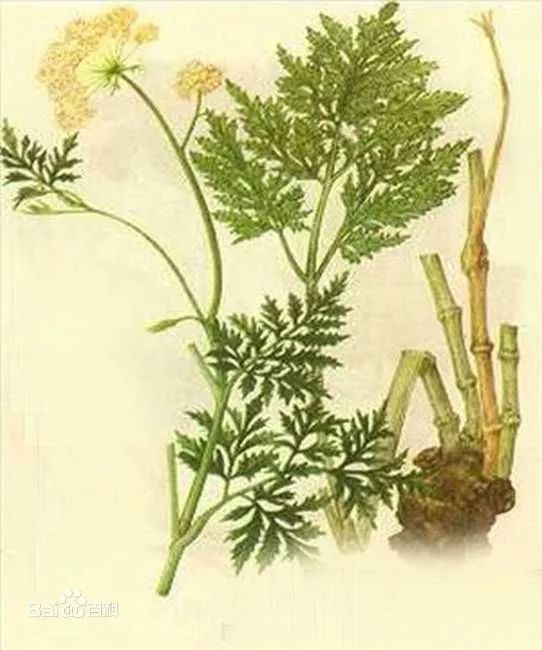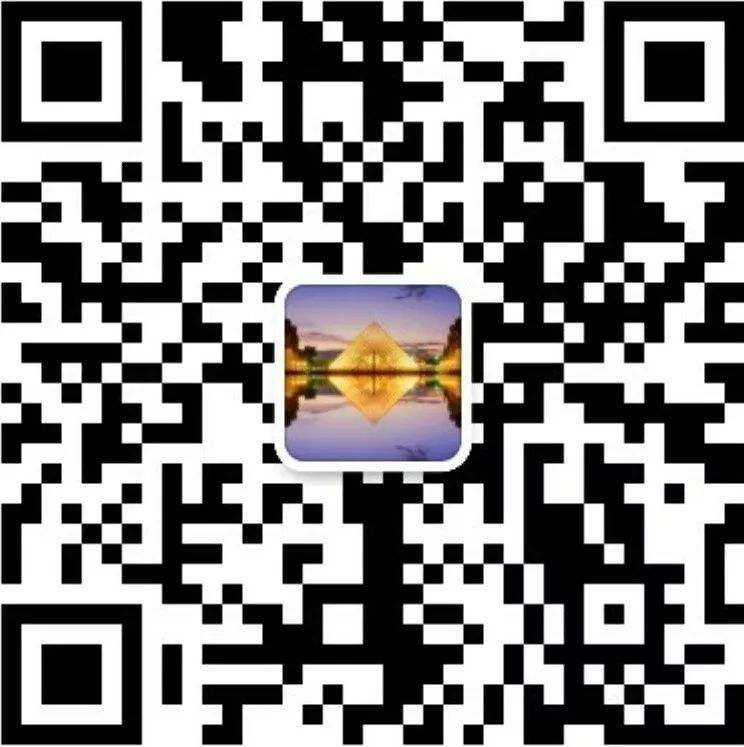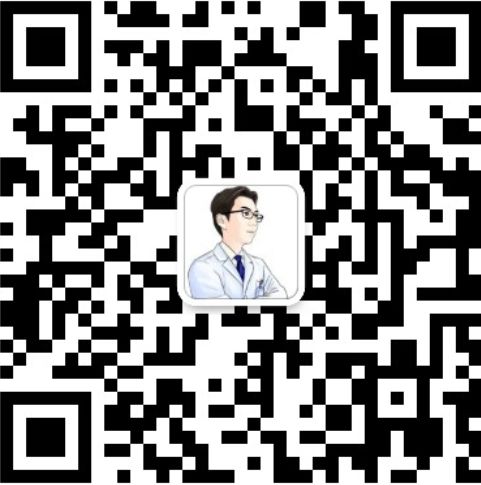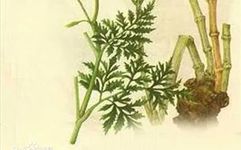Consultation with Physicians, Health Science Popularization, click the above to follow us↑
 1Chuanxiong
1Chuanxiong
Chuanxiong (Scientific name: Ligusticum chuanxiong hort), a cultivated plant, primarily produced in Sichuan (Dujiangyan, Pengzhou), grows in a mild climate. It is a traditional Chinese medicinal plant commonly used to invigorate blood and promote qi, dispel wind and relieve pain. Chuanxiong is acrid, warm, aromatic, and disperses without being retained; it can both ascend to the head and descend to the blood. Its broad blood-invigorating and stasis-removing effects are suitable for various conditions caused by blood stasis; it effectively dispels wind and relieves pain, treating conditions such as headaches and rheumatic pain. Ancient texts referred to Chuanxiong as a qi medicine for the blood, indicating its functions of dispersing, relieving depression, promoting circulation, and alleviating pain.


 2Pharmacological Effects
2Pharmacological Effects
1. Effects on the Central Nervous System
Chuanxiong has a significant sedative effect. When administered in small amounts, the volatile oil of Chuanxiong inhibits brain activity in animals, while it excites the medullary respiratory center, vascular motor center, and spinal reflex center. The volatile oil from Japanese Chuanxiong also inhibits brain activity in animals but excites the medullary vascular motor center, respiratory center, and spinal reflex; increasing the dose leads to a shift to inhibition.
2. Effects on the Cardiovascular System
Effects on the heart: The decoction of Chuanxiong increases the contraction amplitude and slightly slows the heart rate in isolated toad and frog hearts.
3. Effects on Smooth Muscle
A 10% aqueous solution of Chuanxiong extract stimulates the uterus of pregnant rabbits in small amounts, increasing tension and enhancing contractions, leading to spasms; in larger amounts, it causes uterine paralysis and cessation of contractions. Chuanxiong alkaloids, ferulic acid, and ligustilide have antispasmodic effects, with ligustilide being the main component.
4. Antibacterial Effects
In vitro tests show that Chuanxiong inhibits Escherichia coli, Shigella (Sonnei), Proteus, Pseudomonas aeruginosa, Salmonella, paratyphoid bacteria, and Vibrio cholerae.
5. Radioprotective Effects
The decoction of Chuanxiong has certain therapeutic effects in animal experiments for radiation sickness. The water-soluble crude preparation of Chuanxiong protects rats, mice, and dogs from radiation exposure and nitrogen mustard damage.
6. Other Effects
Chuanxiong can increase renal blood flow in anesthetized rabbits and has diuretic effects. It inhibits DNA synthesis, suggesting it can suppress protein and antibody production. Chuanxiong has some effects against vitamin E deficiency, protecting chicks from nutritional encephalopathy due to vitamin E deficiency. Sodium ferulate can reduce lipid peroxidation reactions caused by H2O2 and O2, exhibiting anti-OH and malondialdehyde (MDA) hemolytic effects. Sodium ferulate significantly reduces complement hemolysis and inhibits the binding of complement 3b (C36) to red blood cell membranes.

 3Indications and Functions
3Indications and Functions
Chuanxiong has the functions of promoting qi, relieving stagnation, dispelling wind, and alleviating pain.
It is indicated for wind-cold headaches, dizziness, flank pain, abdominal pain, cold bi syndrome, menstrual disorders, difficult labor, postpartum stasis and pain, and abscesses. It is used for irregular menstruation, dysmenorrhea, abdominal pain, stabbing pain in the chest and flanks, swelling and pain from falls, headaches, and rheumatic pain.
① Shennong Bencao Jing: Treats wind stroke entering the brain, headaches, cold bi syndrome, muscle spasms, traumatic injuries, and women’s blood stasis leading to infertility.② Bielu: Eliminates cold movement in the brain, facial wind, excessive tears, sudden dizziness, various cold symptoms, abdominal pain, and sudden swelling and pain in the flanks.③ Tao Hongjing: For bleeding from the gums, hold it in the mouth for healing.④ Yao Xing Lun: Treats weakness in the waist and legs, hemiplegia, retained placenta, and abdominal cold pain.⑤ Rihua Zibencao: Treats all types of wind, qi stagnation, fatigue, blood issues, replenishes the five fatigues, strengthens muscles and bones, regulates various pulses, breaks up blood stasis, nourishes new blood, promotes flesh growth, nasal bleeding, hemoptysis, hematuria, hemorrhoids, abscesses, and pus discharge.⑥ Yixue Qiyuan: Nourishes blood and treats blood deficiency headaches.⑦ Wang Haogu: Searches for liver qi, replenishes liver blood, moistens liver dryness, and supplements wind deficiency.⑧ Gangmu: Dries dampness, stops diarrhea, and promotes qi to relieve stagnation.

 4Clinical Applications and Combinations
4Clinical Applications and Combinations
① For various wind attacks, heavy head and eyes, unilateral and bilateral headaches, nasal congestion, and body aches: 8 liang of mint leaves (not heated), 4 liang each of Chuanxiong and Jingjie (stems removed), 8 liang of Cyperus (fried), 1.5 liang of Fangfeng (stems removed), 2 liang each of Bai Zhi, Qiang Huo, and Gan Cao (fried); grind these into a fine powder, take 1 qian after meals with warm tea for clarity of the head. (Jufang Chuanxiong Tea Powder)② For unilateral headaches: finely chop Chuanxiong, soak in wine, and take. (Doumen Fang)③ For dizziness and headaches due to wind-cold: 1 jin of Chuanxiong and 4 liang of Tianma. Grind into powder, mix with honey to form pills, take 1 pill after chewing with tea or wine after meals. (Xuanming Lun Fang Chuanxiong Pills)④ For wind-heat headaches: 1 qian of Chuanxiong and 2 qian of tea leaves. Boil in 1 cup of water for 5 minutes, take hot before meals. (Jianbian Danfang)⑤ For abdominal pain during pregnancy (placental obstruction): 2 liang of Chuanxiong, 2 liang of Ejiao, 2 liang of Gan Cao, 3 liang of Ai Ye, 3 liang of Dang Gui, 4 liang of Shao Yao, and 6 liang of Rehmannia. Boil these seven ingredients in 5 sheng of water and 3 sheng of clear wine, take 1 sheng warm, three times a day until healed. (Jinkui Yaolue Ejiao Ai Decoction)⑥ For women in pregnancy (5-7 months) who experience trauma or fetal death, with persistent pain and a desire to use this medicine: if there is no harm, the pain will stop, and both mother and child will be safe; if the fetus is harmed, it will be expelled: 6 liang of Dang Gui (washed, cut, dried, weighed), 4 liang of Chuanxiong (washed). Grind into coarse powder, take 2 qian with a small cup of water, boil until dry, add a large cup of wine, boil once, strain, and take warm, administering as needed. (Ben Shi Fang Buddha Hand Song)⑦ For postpartum blood dizziness: 1 liang of Dang Gui, 5 qian of Chuanxiong, and 2 qian of Jingjie (fried black). Boil in water and take. (Qifang Lei Bian)⑧ For postpartum abdominal pain: 1 liang each of Chuanxiong (washed, chopped), Gui Xin (not heated, chopped), Mu Xiang (chopped, dried), Dang Gui (remove hairs, washed, chopped, dried), and Tao Ren (remove skin, tips, and double kernels, fried yellow). Grind into fine powder. Take 1 qian with hot wine, or if unwilling to drink wine, use 1 cup of water with 2 qian of powder, boil until 7 parts remain, take warm. (Weisheng Jiabao Fang Chuanxiong Powder)⑨ For postpartum stasis pain: 8 qian of Dang Gui, 3 qian of Chuanxiong, and 14 pieces of Tao Ren (remove skin, tips, ground). Boil with yellow wine and children’s urine in equal parts. (Fu Qingzhu Nanke Shenghua Decoction)⑩ For children’s brain heat, favoring closed eyes, with pain in the temples or red swollen eyes: 2 qian each of Chuanxiong, mint, and natron, ground into powder and blown into the nose. (Quanyou Xinjian)

 5Precautions for Use
5Precautions for Use
Should be avoided by individuals with yin deficiency and excess fire, those with excess above and deficiency below, and those with weak qi.① Bencao Jing Jizhu: Bai Zhi is a guiding herb. Avoid Huanglian.② Pinhui Jingyao: Prolonged use may disperse true qi.③ Bencao Mengquan: Avoid Huangqi, Shanzhu, and Wolf Poison. Avoid Nitrate and Talc, Huanglian. Antagonistic to Li Lu.④ Bencao Jingshu: For patients with excess above and deficiency below, yin fire flaring up, vomiting, coughing, spontaneous sweating, easy sweating, night sweats, dry throat, dry mouth, fever, thirst, and irritability, it should be avoided.⑤ Bencao Congxin: Not suitable for qi rising with phlegm and wheezing.⑥ Depei Bencao: Avoid in cases of severe internal fullness, spleen deficiency with little food intake, and headaches due to stagnant fire.
Let’s also take a look at the video on Chuanxiong:
 —END—
—END—


Health Management | Physician Consultation
Chronic Disease Education | Expert Classroom

